E-Museum of Pyrographic ArtAntique Art Hall
|
| - Café Flambé - | - Portraits and Paintings - | - Decorative and Applied Art - |
| - Folk and Traditional Art - | - Antique Art - | - Special Hall - | - Sculpture - |
| - Children's Hall - | - Bookstore and Library - | - Tools and Techniques - |
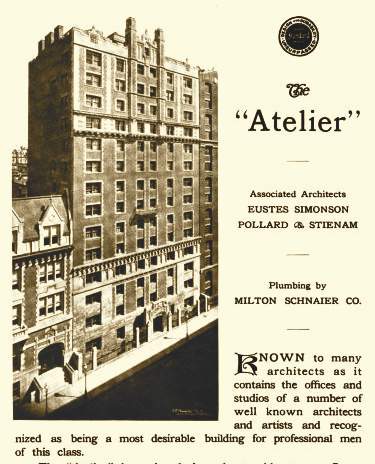 |
| The Atelier Building 33 West 67th Street, New York City Adapted from an early 20th C. black-and-white photograph of the Atelier Bldg. From an advertisement in the catalogue of the Architectural League of New York |
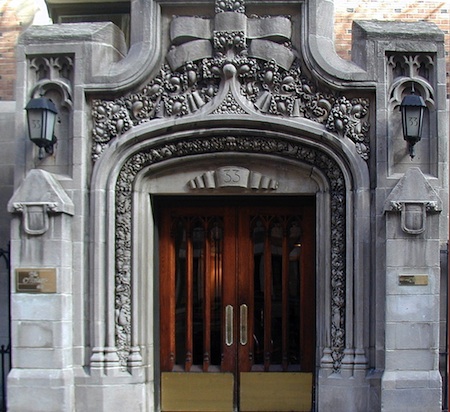 |
| The Atelier Building, Detail of the Front Entrance 33 West 67th Street, New York City Adapted from a circa 2010 photograph of The Atelier Building By photographer Chester Burger. |
According to Historian Jeff Richman of Green-Wood (who refers to the AIA Guide to New York City), this "remarkable" early 20th C. building is one of the first "co-op buildings" in New York City, and features "twenty-six foot ceilings, thick rock walls to suppress noise, [and] original electric and gas fixtures."
His Studios
The famous Atelier Building (pictured above) was a later structure and considered no doubt quite prestigious. It was the latest address (at least in New York City) where J. William Fosdick had a studio and residence. Even after his death in 1937, his widow continued to live there until her death in 1961.
Fosdick's spacious, elegant studio residence in the Atelier Building is illustrated and described in depth in a three-page article by Ada Rainey in the July 1914 issue of Arts and Decoration Magazine, entitled
The DECORATIONS OF A GOTHIC STUDIO: The New York Home
of J. William Fosdick (p. 341), page 342, and page 343.
In the opening image, the interior photograph of Fosdick's studio shows how very beautiful it was, and shows a nine-foot-high work on the left hand side of the wall, which, although barely visible, is nonetheless obviously his 1896 triptych of The Glorification of Joan of Arc.
Ada Rainey's article is now available on Google Books, as well, where his 1896 triptych of The Glorification of Joan of Arc is more readily discernible.
Note that a 1970 color photograph of Ulysses in the Land of the Lotus Eaters can be viewed in the segment for Fosdick's 1900 Exhibition at the Lotos Club in New York City, displayed farther down on this page.
Italian-born composer, conductor and singing teacher Alberto Randegger was widely known for his textbook entitled Singing published in 1879 that is still in use today. He made his career promoting opera and new works of British music in England during the Victorian era.
 |
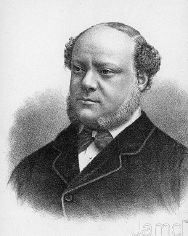 |
| 1905 Randegger Concert in J. William Fosdick's Studio in the Atelier Building in New York City Adapted from an article segment in the Timely Musical Comment. Bio excerpt on Randegger courtesy of Wikipedia. |
This small item in the newspaper highlights one more aspect of the prominent social milieu
of J. William Fosdick and his wife Gertrude Christian Fosdick.
The following little piece was published in 1902 when J. W. Fosdick's novel "The Honor of the Braxtons" was being introduced. Unfortunately, it does not specify which First Lady it was who dubbed him with a nickname. Perhaps, considering the time frame mentioned, it was Frances "Frank" Cleveland, who was known to be a very popular hostess in her time.
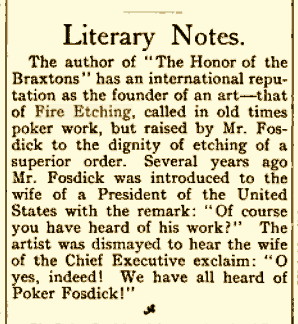 |
| Literary News Item City and state Volume 12, Philadelphia: 2 January 1902, p. 252. |
Thanks once more to Google Books and a second article featuring J. Wm. Fosdick's studio apartment in the Atelier Building, this time from a 1907 issue of Architectural Record, we now have two additional images (below), each with helpful descriptive captions. The 1907 picture of his studio below, however, has been cropped top and bottom.
In the first one (Ada Rainey's 1914 article), where the ceiling edge and a lamp are visible, by calculating the things we can readily estimate, we had estimated the height of the room to be probably at least fifteen feet. However, now that we have still two more accounts—from historian Jeff Richman (quoted above) and Bob Hill, Gertrude Fosdick's cousin (quoted following)—it seems the ceiling included a slanted skylight and soared an astonishing twenty-six feet.
*** UPDATE—24 August 2011: Mr. Robert E. Hill of Richmond, Virginia, offers us here, in his own words, his firthand description of the luxurious "ATELIER" apartment of J. William and Gertrude Christian Fosdick, remembered from his own visits there during the 1950's:
"I was particularly interested in the article describing the Fosdick
apartment and seeing the picture of the fireplace, however murky.
That's exactly what I remember. I have always been somewhat
reluctant to try to describe that apartment, for fear of being
accused of gross exaggeration, or at least hyperbole. I've never
since seen anything quite like it.
One entered onto a balcony
overlooking this huge, 2- story space. Straight stairs led down
to the main floor and on the left a vast, slanted skylight
dominated one wall (presumably north facing).
I particularly
remember three things: the fireplace (pictured), the tapestry
(mentioned) and a magnificent mahogany highboy, with broken
pediment and flame finials. The rest of the astonishing
decorative art objects and furnishings were consistent with the
few shown in the picture.
Cousin Gertrude's eyesight had failed
considerably and shades were drawn over much of the skylight to
keep out the brightness. This gave the place a muted and almost
gloomy aspect.
At the time of my visits she had a companion
living with her, a Miss Sparrow. "She's English, you know",
I was told by Cousin Gertrude with a twinkling eye. I also recall
that there were several of her small bronze sculptures on a
console table, but unfortunately I remember nothing specific
about them."
In a follow-up dialogue, Bob Hill goes into still more detail about the intriguing configuration of the rooms in the Fosdicks' beautiful studio. Refer to the two images immediately below to see what he is describing.
"To answer your specific question about the dining room, the door visible on the left in the photo leads, on the same level, into the main room. As one stood facing the fireplace, the dining room was directly (90 degrees) to the right. Along the same wall, in the corner (about 45 degrees) was a hallway leading back into the living quarters. I did go into the dining room, but never into the living quarters so have no idea how it was configured. Since the dining room was only one story tall, perhaps there was a bedroom above the dining room. But that is pure conjecture. The entry balcony, however, was no more than a balcony. No other room was visible at the same entry level."
"I was particularly interested in the article describing the Fosdick apartment and seeing the picture of the fireplace, however murky. That's exactly what I remember. I have always been somewhat reluctant to try to describe that apartment, for fear of being accused of gross exaggeration, or at least hyperbole. I've never since seen anything quite like it.In a follow-up dialogue, Bob Hill goes into still more detail about the intriguing configuration of the rooms in the Fosdicks' beautiful studio. Refer to the two images immediately below to see what he is describing.
One entered onto a balcony overlooking this huge, 2- story space. Straight stairs led down to the main floor and on the left a vast, slanted skylight dominated one wall (presumably north facing).
I particularly remember three things: the fireplace (pictured), the tapestry (mentioned) and a magnificent mahogany highboy, with broken pediment and flame finials. The rest of the astonishing decorative art objects and furnishings were consistent with the few shown in the picture.
Cousin Gertrude's eyesight had failed considerably and shades were drawn over much of the skylight to keep out the brightness. This gave the place a muted and almost gloomy aspect.
At the time of my visits she had a companion living with her, a Miss Sparrow. "She's English, you know", I was told by Cousin Gertrude with a twinkling eye. I also recall that there were several of her small bronze sculptures on a console table, but unfortunately I remember nothing specific about them."
"To answer your specific question about the dining room, the door visible on the left in the photo leads, on the same level, into the main room. As one stood facing the fireplace, the dining room was directly (90 degrees) to the right. Along the same wall, in the corner (about 45 degrees) was a hallway leading back into the living quarters. I did go into the dining room, but never into the living quarters so have no idea how it was configured. Since the dining room was only one story tall, perhaps there was a bedroom above the dining room. But that is pure conjecture. The entry balcony, however, was no more than a balcony. No other room was visible at the same entry level."
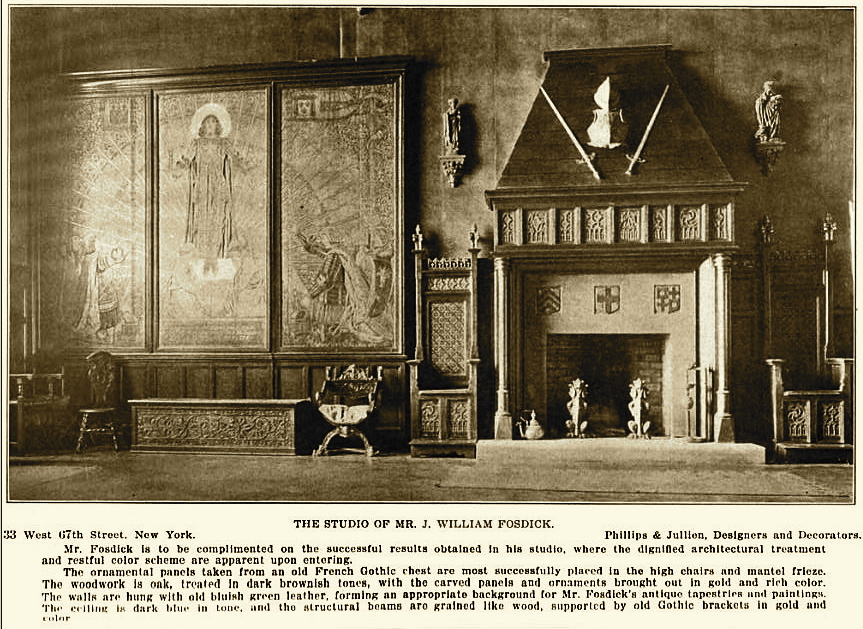 | 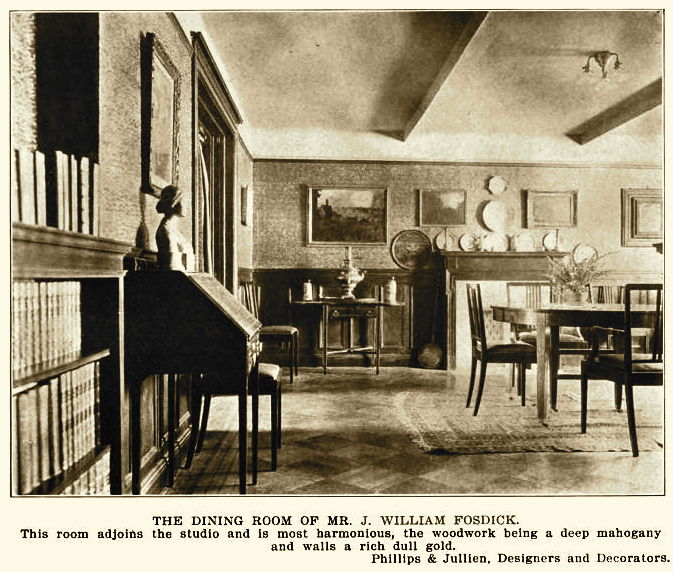 |
| J. William Fosdick's Studio in the Atelier Building in New York City Adapted from the article, "Some Interesting Studio Apartments" in the Atelier Building, 33 West 67th Street, New York from the Architectural Record, Vol. XXI, January–June, 1907, pp. 385–388. |
Although Ada Rainey talked in her article about the triptych, she did not name it. She did, however, note that it was no longer there because the work was part of the Evans collection at the Smithsonian in Washington, D.C.
In truth, because William T. Evans donated that work to the National Gallery of the Smithsonian in 1910, the photograph illustrating Ada Rainey's article must have been at least four years old when it was published in 1914*. And Fosdick must have hated to see his 9-foot-by-13-foot triptych depart, because his studio must have looked most impressive with those three grand panels there.
* In light of the 1907 article found in 2009, it now seems that those photographs of J. Wm. Fosdick's studio were at least seven years old. It is also believed that Fosdick's Joan of Arc triptych also spent some time on loan to the Boston Art Museum, so he may have had them in his studio for only a limited time.
Apparently in 1922 there was "trouble in paradise" even in that idyllic studio. Fosdick wrote two editorials of complaint to the New York Times that year. One was about the noise on Sundays from the hydroplanes passing overhead when people wanted to enjoy sitting on the rooftops of their buildings. This one below indicates his landlord was allowing entrance to some less than satisfactory tenants who were "ruining the neighborhood." No one likes bad neighbors.
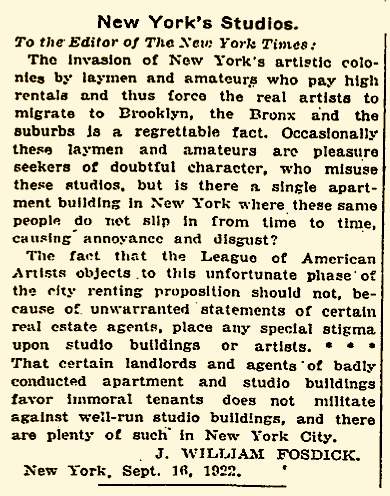 |
| New York Studios Editorial in the New York Times Published 19 September 1922. |
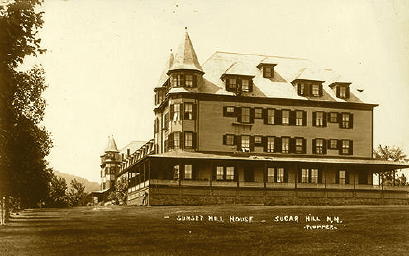 |
| Sunset Hill House The Nutshell, J. William Fosdick's Summer Studio was one of the cottages at Sunset Hill House Located in the town of Sugar Hill, in the White Mountains of New Hampshire, U.S.A. Adapted from a period photograph of what was the original Sunset Hill House until 1974. Today Sunset Hill House is a country inn. At the link here, read the history of it as told by its present owners. |
Excerpts from a July 1905 New York Times column "IN THE WHITE MOUNTAINS":
"BRETTON WOODS, N.H., July 8. — The season here was given a decided impetus. There came with Saturday the greatest influx of visitors ever known on a single day in the White Mountains. The New York train brought fifteen carloads of visitors, to the hills, and from Conway to Colebrook every station sent its full quota of holiday makers laden with golf sticks, tennis racquets, fishing tackle, and other outing paraphernalia...."
"J. William Fosdick, the New York artist, has rented the Nutshell to friends, as he is obliged to remain in New York this Summer."
Excerpt from a July 1912 New York Times column "THE SEASON AT SUGAR HILL":
"Old Friends Largely Make up Colony
At This Favorite Beauty Spot"
"Seek the whole world over and you
will find no such view as greets one from
the Sunset Hill house at Sugar Hill, supremely beautiful in its color masses,
simplicity, majesty; strangely fascinating under subtle influence of sun and
shadow, dawn and dusk.
For the season now well begun, many affairs are
planned, golf leading in outdoor sports,
with social affairs radiating from the
usual Saturday evening dances,....
Among the first of the cottagers to
arrive was Mr. J. William Fosdick, the
artist, who is at his studio, the Nutshell.
Mrs. Edwin B. Holden and family of
New York, return to the Vista.
Professor and Mrs. F. H. Hill and family of
Carlton College, Northfield, Minn., are
among the new comers.
Dr. and Mrs. W. H. Haskin, and Mr. and Mrs. W. J.
Parslow of New York lease the Adams
villa. Mr. and Mrs. George Stevenson
and family of Philadelphia, are at
Glamorgan Cottage."
"J. William Fosdick, the New York artist, has rented the Nutshell to friends, as he is obliged to remain in New York this Summer."
"Seek the whole world over and you will find no such view as greets one from the Sunset Hill house at Sugar Hill, supremely beautiful in its color masses, simplicity, majesty; strangely fascinating under subtle influence of sun and shadow, dawn and dusk.
For the season now well begun, many affairs are planned, golf leading in outdoor sports, with social affairs radiating from the usual Saturday evening dances,....
Among the first of the cottagers to arrive was Mr. J. William Fosdick, the artist, who is at his studio, the Nutshell.
Mrs. Edwin B. Holden and family of New York, return to the Vista.
Professor and Mrs. F. H. Hill and family of Carlton College, Northfield, Minn., are among the new comers.
Dr. and Mrs. W. H. Haskin, and Mr. and Mrs. W. J. Parslow of New York lease the Adams villa. Mr. and Mrs. George Stevenson and family of Philadelphia, are at Glamorgan Cottage."
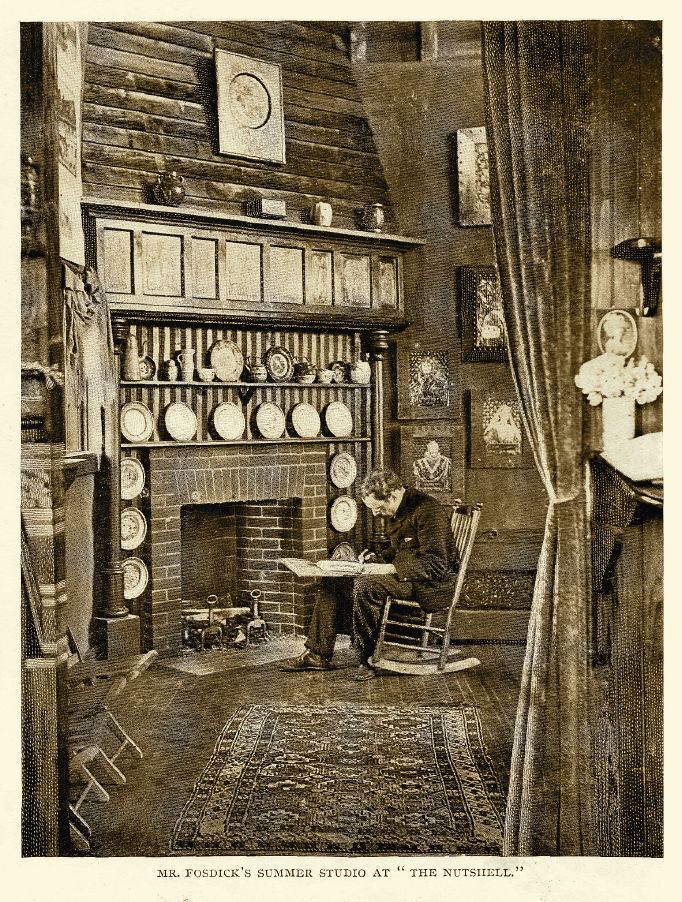 |
| A Visitor at J. William Fosdick's Summer Studio "The Nutshell" in the White Mountains of New Hampshire Adapted from a black-and-white photograph, published in Puritan Magazine, July 1897, p. 225. |
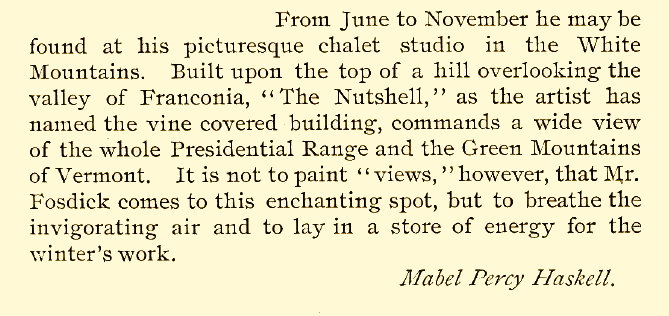 |
| Excerpt on J. William Fosdick's Summer Studio "The Nutshell" in the White Mountains of New Hampshire Excerpt adapted from the article The Founder of a New Art in Puritan Magazine, July 1897, p. 225. |
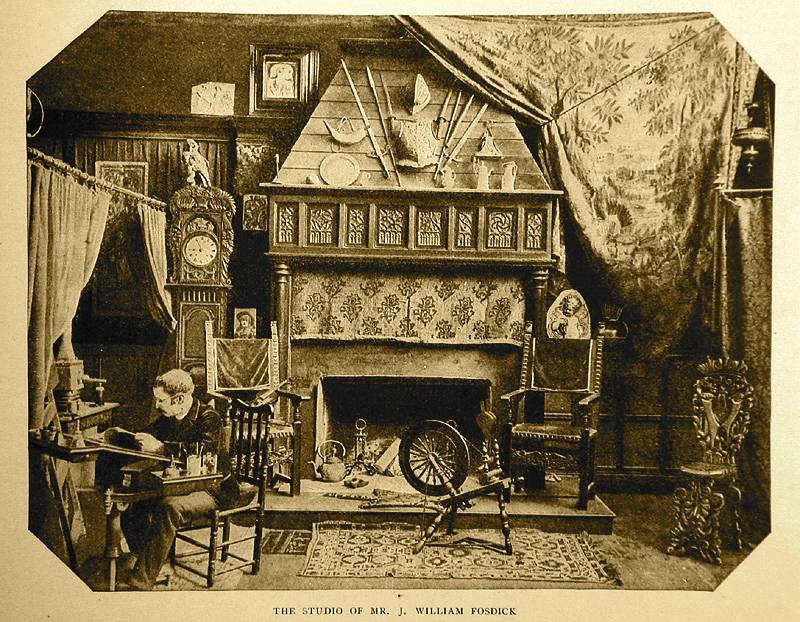 |
| J. William Fosdick Posing at Work in an Earlier Studio in New York City Located at 58 West 57th Street (near Carnegie Hall) Adapted from a circa 1890 black-and-white photograph |
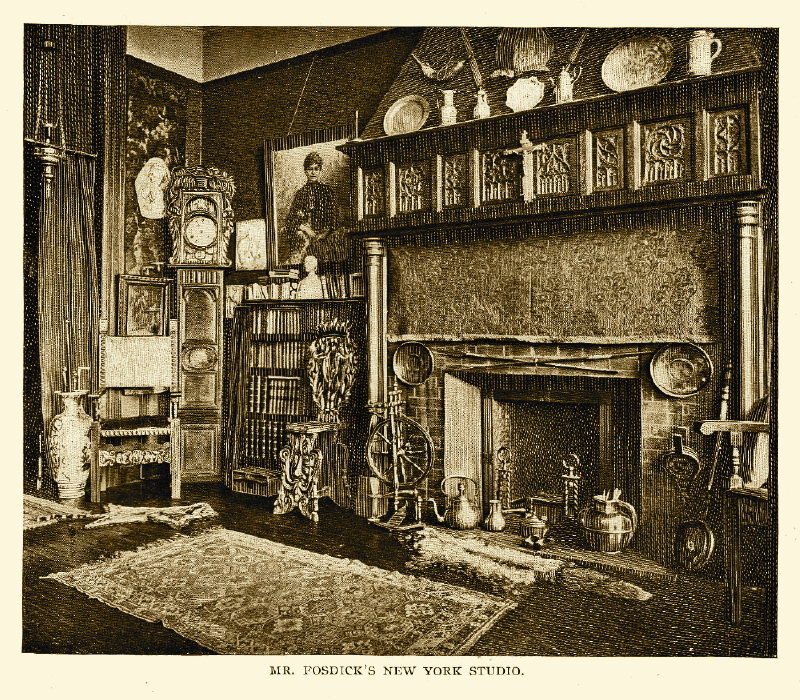 |
| Another View (at Another Time) of J. William Fosdick's Earlier Studio in New York City Located at 58 West 57th Street (near Carnegie Hall) Adapted from a black-and-white photograph, published in Puritan Magazine, July 1897, p. 224. |
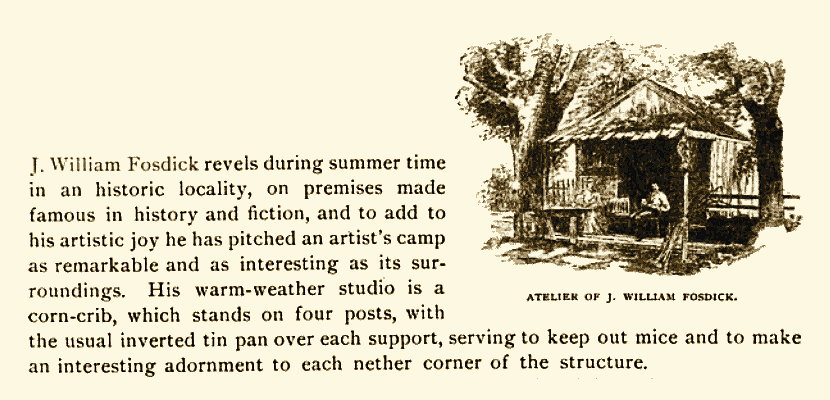 |
| J. William Fosdick's Summer Studio or Atelier circa 1893 Adapted from a drawing by him on p. 216 in an 1893 article in The Monthly Illustrator entitled THE SUMMER STUDIOS OF AMERICAN ARTISTS, pp. 209–224. |
Apparently before J. William Fosdick had his summer studio cottage in New Hampshire called "The Nutshell," he had a very rustic one that he had fashioned himself. The article excerpted here above, replete with small original drawings rendered by the artists themselves of their respective summer studios, failed to mention where exactly Fosdick's was located. This one, referred to only as his"atelier" in the caption did not appear to have been given its own special moniker as his later one had.
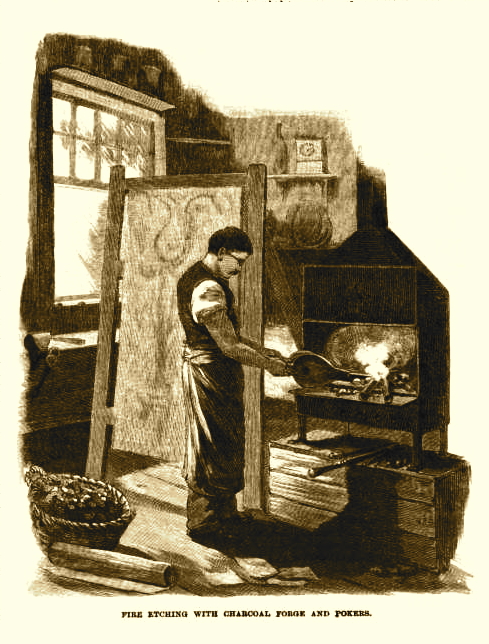 |
| J. William Fosdick at Work In a makeshift studio in a schoolhouse in the summer of 1884 Adapted from an illustration on p. 121 in an 1892 article by Franklin Smith in Frank Leslie's Popular Monthly entitled Etching With Fire. |
In 1884, J. Wm. Fosdick sailed from Paris, where he was studying,
back to New York to do a special job—a commission for E. D. Adams
for a frieze in his New York City house. The panels were sent to a
workshop he set up in Massachusetts. Read the story at the link here.
His Societies and Exhibitions, also Lectures
It was thanks to J. Wm. Fosdick's listings in the various magazine and newspaper articles and announcements, year books, and catalogues of the various societies and organizations to which he belonged that we learned of his studio and residential addresses over the years and the exhibitions in which he participated.
And it was thanks to his participation in many of those societies, no doubt, that he was able to meet and work for major entrepreneurs of his time and their architects, in addition to fellow artists and others, such as publishers and the press, who were essential in recommending, contracting, publicizing, and promoting his work.
Many of these organizations also provided venues for exhibitions, as well as catalogues. Following is a list of the societies to which J. William Fosdick was known to be a member. In some, he is listed as a non-resident member in one section showing an address other than New York City, and listed again in a separate section as a resident member showing an address in New York City. In most of these organizations he was not only an active member but one of the officers. Where this is the case, his position(s) held are noted in parentheses after each:
The New York Architectural League (Secretary)
The National Society of Mural Painters (Secretary)
The Copley Society (President and Lecturer)
The National Society of Craftsmen, New York (Director, Vice President)
The National Arts Club, New York
The Arts and Crafts Society of America (President)
The New York Camera Club (Judge and Lecturer)
Julian's Ancients (Les Anciens de Julian)
Also known as the American Alumni of the Julian Academy (Founder, President)
Organized in 1908; annual reunions held in the Hotel Brevoort.
*** UPDATE—14 June 2010: Thanks to Google Books, the E-Museum has discovered a newly published book Ernest Clifford Peixotto: American Artist. Lovingly written by the artist's nephew and namesake, it is the biography of another great artist, who, like J. William Fosdick, studied at the Académie Julian.
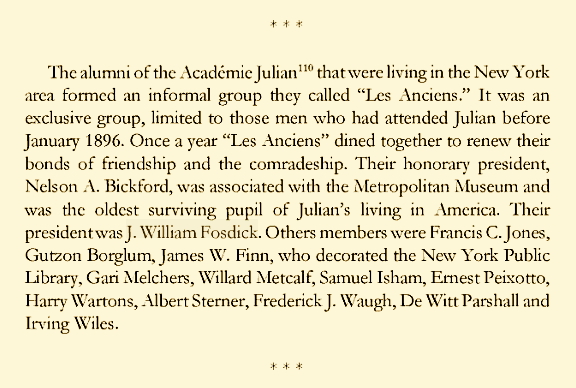 |
| Excerpt, p. 200, from the book Ernest Clifford Peixotto: American Artist
By the artist's nephew and namesake, Ernest D. Peixotto Published by PublishAmerica, Baltimore, Maryland, U.S.A., 2010. |
*** UPDATE—2 July 2011: From the New York Tribune is a 1908 article JULIAN'S 'ANCIENS' REVIVE MEMORIES describing a reunion and a stereopticon slide show of pictures of J. William Fosdick and old friends, all who studied at the revered and fondly remembered Académie Julian in Paris.
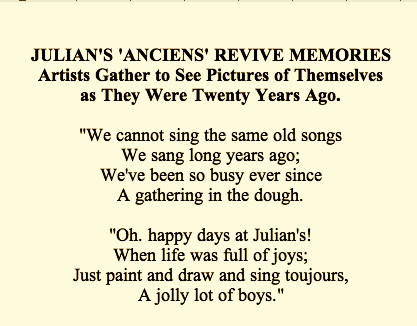 |
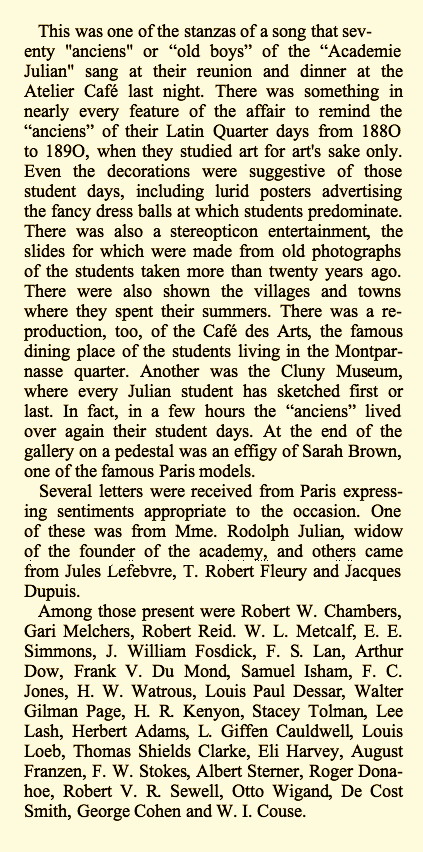 |
| Reunion of Julian's Anciens at the Atelier Café |
1889 Exhibition at the Galleries of the
American Art Association in New York City
and the
1889 Exhibition at the St. Louis Museum of Fine Arts
Although as yet no catalogue has been discovered for the New York 1889 Exhibition of Burnt Wood Panels by J. Wm. Fosdick, held in the Galleries of the American Art Association, research has revealed that Fosdick returned to America in 1888 with the works he had shown in Paris upon finishing his studies there. Encouraged by his professors from the Académie Julian, he began showing them in the United States in New York and St. Louis. Therefore, it seems safe to say that the 28 works shown in St. Louis and listed in their catalogue, linked here, should accurately represent his works shown in New York City, as well.
1893 World's Columbian Exposiition
at the Art Palace in Chicago
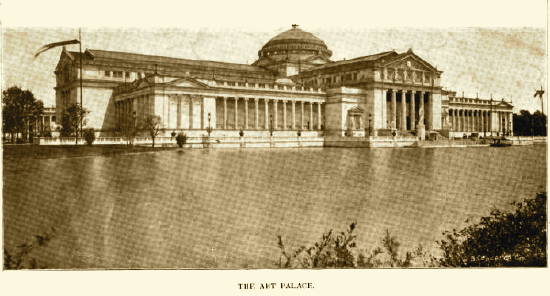 |
| The Art Palace Exhibit building at the 1893 World's Columbian Exposition in Chicago, Illinois, United States of America |
According to the catalogue for this exhibition, on p. 133, J. William Fosdick exhibited his "burnt wood drawing" from 1888 entitled Lady Godiva, which was number 2695 and hung on the east wall of the north court, near the entrance to the staircase at the northeast of the Rotunda. This work can be viewed at the link for the 1889 Exhibition in St. Louis in the previous entry.
Atlanta Exposition, 1895
Awarded Grand Gold Medal for mural decoration,
for his frieze of Henry VIII The Field of the Cloth of Gold
*** UPDATE—12 July 2011: Thanks to a recently discovered 1897 article, we now know
that this famous frieze has FOUR PANELS. Its full title is
THE MEETING OF FRANCIS I OF FRANCE AND HENRY VIII OF ENGLAND
ON THE FIELD OF THE CLOTH OF GOLD
and it can be viewed at the link here to that title.
1896 Exhibition and Lecture at
The Pennsylvania Academy of the Fine Arts in Philadelphia
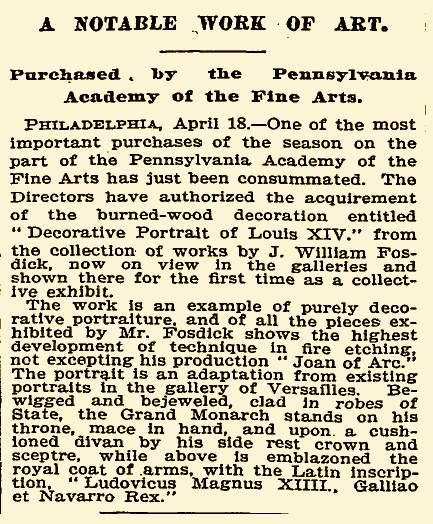
J. William Fosdick, April 19, 1896
Exhibiting at The Pennsylvania Academy of Fine Arts (PAFA)
in Philadelphia
Adapted from a New York Times article
A 20-page catalogue (exhibited at the link here in the E-Museum) was published for this (joint) exhibition that was entitled,
A Representative Collection of the Glasgow School of Painting. The Adoration of Jeanne D'Arc and Other Burnt Wood Decorations
By J William Fosdick.
Notes on the Louis XIV panel:
1. The last two lines reflect errors in the automated transcription of the original article: The quotation at the end should say: "Ludovicus Magnus XIIII, Galliae et Navarrae Rex," i.e., Louis the Great XIV, King of Galle and Navarre.
2. The Roman numeral for 14 on the panel is written with an X and four I's vs. the usual XIV.
3. The lettering is all gilded, which, unfortunately, does not show up in the black-and-white photograph of the Louis XIV panel and its adapted digital image in the E-Museum.
4. This massive panel was acquired by PAFA in 1896 and is still there today, available (by appointment) to view in their archives.
1900 Exhibition at the Lotos Club in New York City
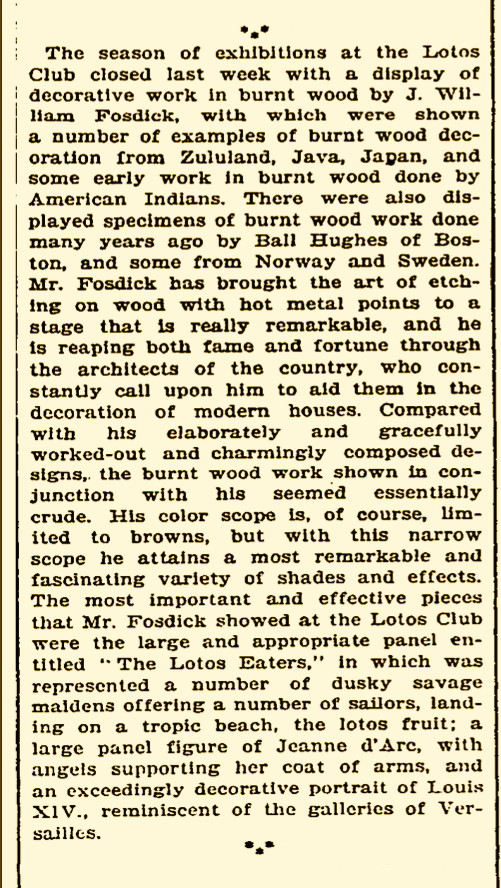
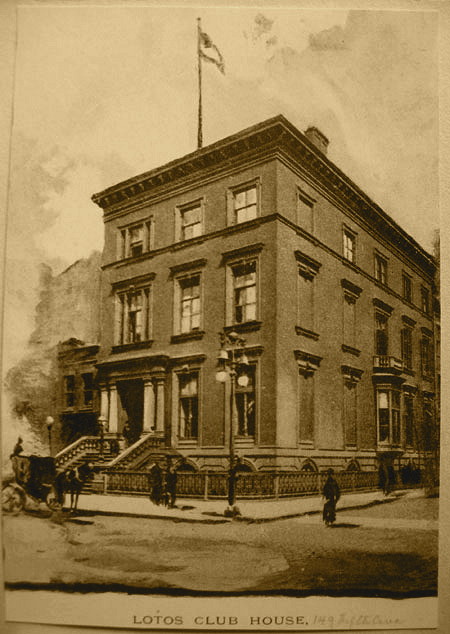
J. William Fosdick, 1900
Exhibiting at the Lotos Club in New York City
Excerpt adapted from a May 12 article in the New York Times
This exhibition was broad in scope, because J. Wm. Fosdick exhibited not only some of his largest, most impressive works there at the Lotos Club in New York City, but he also exhibited the two works he owned by Ball Hughes, as well as a collection of folk and traditional works from Africa, Asia, Europe, and America.

J. William Fosdick, 1900
Exhibiting at the Lotos Club in New York City
Excerpt adapted from volume 3 of the 1900 American Art Annual
Immediately above is one more publication about the same exhibit detailed above it in the New York Times article. It is another indication of how well connected J. William Fosdick was during his own time, and that he was nationally recognized at the highest social and professional levels. Note that the Chairman of the Art Committee for this event was William T. Evans, Fosdick's best patron.
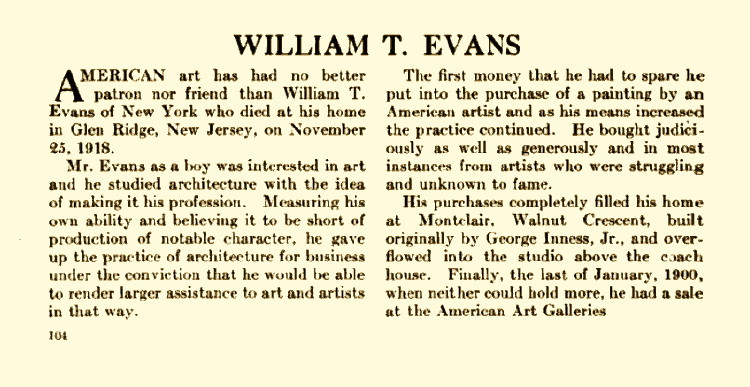
William T. Evans, circa 1918
Patron and Member of the Lotos Club in New York City
Excerpt adapted from volume 3 of the 1918 American Art Annual
This excerpt is an introduction from another publication about William T. Evans, Fosdick's best patron and art's best patron, as well, at that time. His predilection for Fosdick's work was evident time and time again. As chairman of the Lotos Club's Art Committee, Evans was likely the reason that Fosdick's beautiful panel Ulysses was part of that 1900 exhibit and also was acquired then as the decoration over the mantel in the Grill Room of that exclusive club, where it remains to this day.
Following is a link to William T. Evans' 1905 speech at the Lotos Club, in which he honors the newly appointed director of New York's Metropolitan Museum. His speech offers some genuine insight into the simple beginnings of some of the major museums we know today and ends with a quote from Austin Dobson:
All passes; Art, alone
Enduring, stays to us.
The bust outlasts the throne;
The coin, Tiberius.
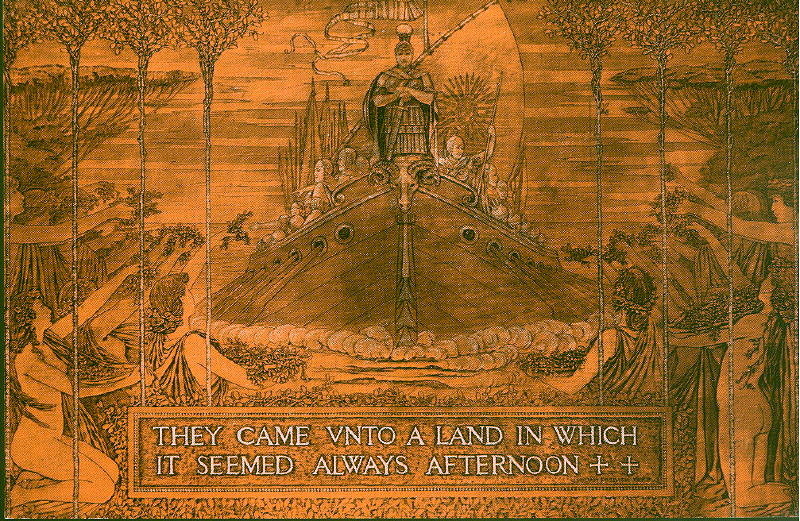
ULYSSES AND THE LOTOS EATERS
By J. William Fosdick, 1900
The Lotos Club Grill Room (the Club's restaurant) in New York City
The inscription at the bottom is from Tennyson's poem "The Lotos Eaters," and is the club's motto.
Pyrography on wood, approximately 8 ft. wide by 5 ft. tall
The above image is from a photograph taken in 1970 showing how Fosdick's panel Ulysses looked back then—at the age of 70!—in its place of honor over the mantel of the Lotos Club's Grill Room restaurant. The Club's Archivist Nancy Johnson provided the above photograph and noted that the original art work, which still hangs—now 112 years later!—over the mantel there in the Grill Room, is darker than it appears in that 1970 photograph, and does not have the white highlights that appear there. It seems probable that the original panel never had any white in it. Because that 1970 photograph was taken to be used as the cover illustration in one of the Lotos Club's publications at that time, it seems likely the white highlights that can be observed there were added to the photograph itself to compensate for the areas of natural wood that had darkened over time.
Although Ms. Johnson could not locate a catalogue of that 1900 exhibition, she did find "a letter inviting Lotos Club members to the showing of "Fire Etched Mural Decorations," including the panel the artist did for the Club."
Fosdick's "The Landing of Ulysses in the Land of the Lotos Eaters" panel has been illustrated in four known articles about the artist: the 1901 piece in the American Studio Talk column; the 1909 article The Art of Fire Etching in Palette and Bench magazine; the 1909 article Fire Etching in Home Decoration in Country Life magazine; and the July 1914 article The Decorations of a Gothic Studio: The New York Home of J. William Fosdick by Ada Rainey for Arts and Decoration magazine.
Two 1901 Exhibitions in New York City:
The Society of American Artists
and
The Architectural League of New York
Published in The International Studio are segments from a feature article entitled "Studio Talk" with critiques and four lovely illustrations of two
1901 Exhibitions in New York City of J. Wm. Fosdick's burnt wood panels.
J. William Fosdick's Lecture at the 1907 Exhibition of the National Society of Craftsmen in New York's National Arts Club
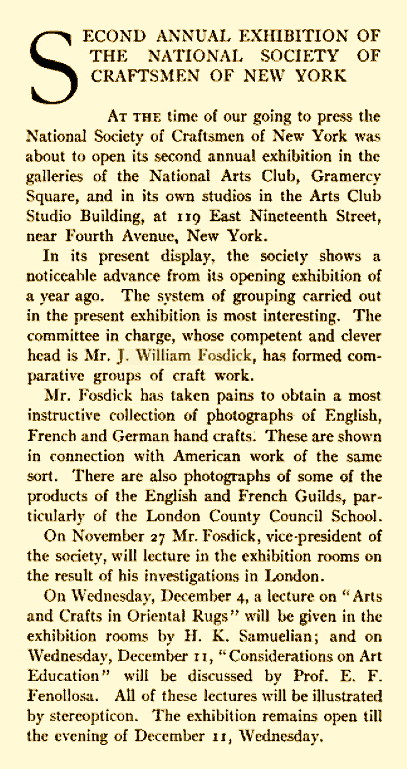
November 1907 Review of J. William Fosdick's Exhibition
of the National Society of Craftsmen of New York
Published in The International studio, Volume 33, p. lxx.
This announcement of the National Society of Craftsmen's Second Annual Exhibition is one more example of this artist's industrious lifestyle and an example for ambitious artists of today to follow if they wish to succeed. He not only exhibited his own work here, we are to suppose (although the article does not specify that), he was chairman of the joint exhibition committee that organized it; initiated a new way to display it from how it had been done the previous year; brought his photographs to show (that he had taken during his research abroad); and gave a lecture (using the stereopticon) comparing American work with that he had seen in his travels to Germany, England, and France.
1911 Lecture in Boston:
The Boston Society of Arts and Crafts
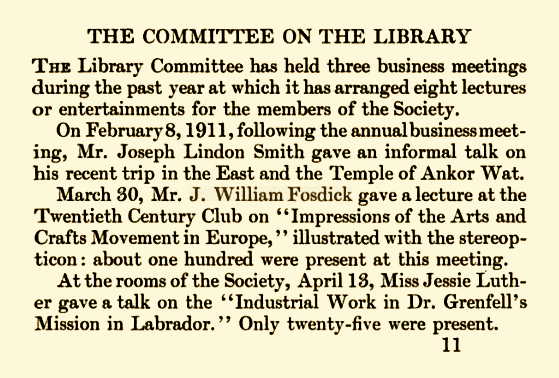
J. William Fosdick
1911 Lecture in Boston
Published in their 1912 Annual report are the following three lectures given the previous year at the three business meetings of the Library Committee. Note Fosdick's use of the stereopticon for his lecture entitled Impressions of the Arts and Crafts Movement in Europe.
1915 Exhibition at the St. Botolph Club in Boston
Published in Volume 13 of The American Art Annual is this listing for the 1915 exhibition of J. Wm. Fosdick's "paintings"at the St. Botolph Club
in Boston from December 11–31.
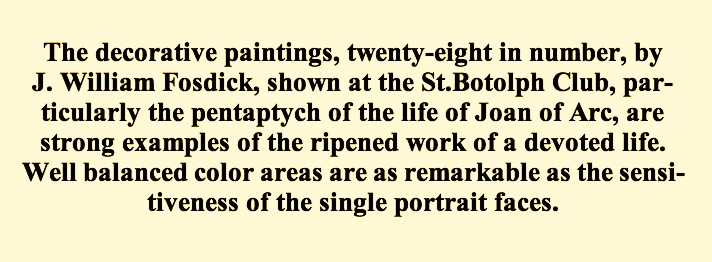
February 1916 Review of J. William Fosdick's Exhibit
Published in ARTS AND DECORATION, Volume 6, Issue 4, p. 189.
1916 Exhibition of the National Society of Craftsmen
of Three of J. Wm. Fosdick's Seven Panels
Destined for the National Arts Club Grille
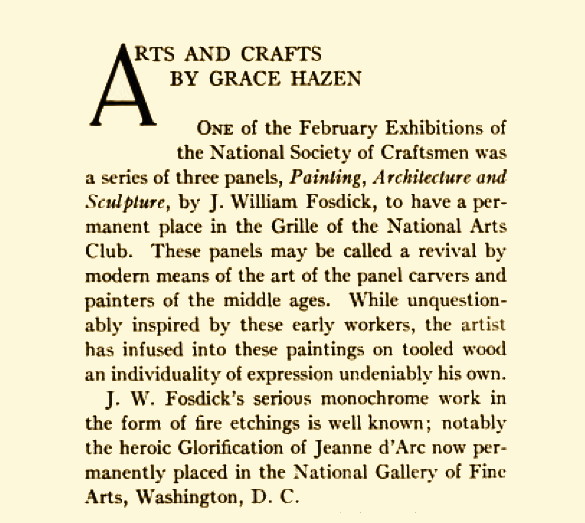
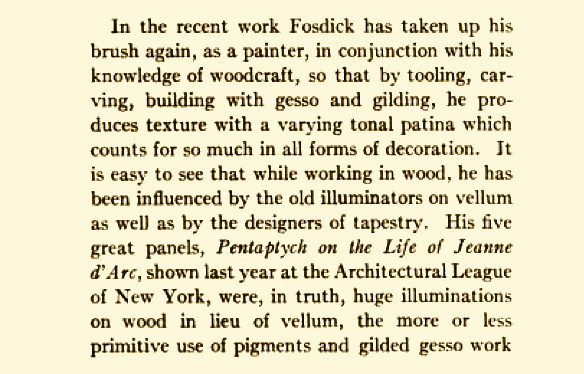
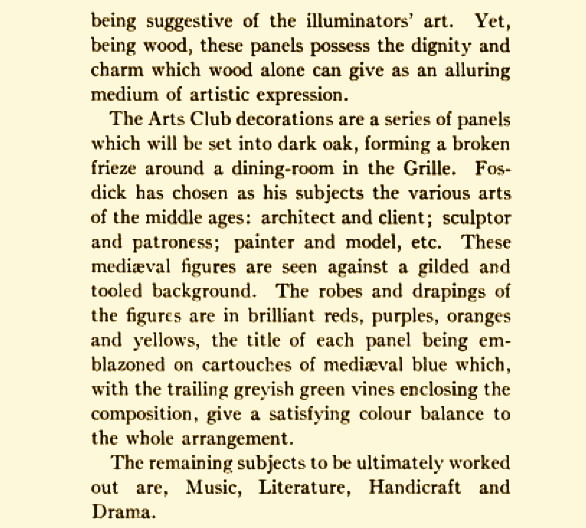
ARTS and CRAFTS
by Grace Hazen
Excerpt on J. William Fosdick from a 1916 article, published in the New York Offices
of the International Studio Magazine, Volume 58, Issues 229–232, page xli.
Posthumous Exhibition in 2003:
Traveling Tour of The Gilded Age
Treasures from the Smithsonian American Art Museum
The Cleveland Art Museum
"As the [Smithsonian American Art Museum's] building in Washington, D.C., [was undergoing] extensive renovation, the institution decided to tour [a] magnificent assemblage of highlights from the collection and to share them with the nation at large." Among the treasures exhibited in that tour was J. William Fosdick's triptych of St. Joan of Arc. Click on the Cleveland Art Museum link to see the story of that event.
* Update, June 2012: A 90th Anniversary Exhibition is planned at the
The North Shore Arts Association at 11 Pirates Lane in Gloucester, Massachusetts, from August 16 to September 18, 2012. There will be a reception held there on Sunday, August 19, 2012, from two to four o'clock. Represented there among other artists' works will be works by Gertrude Christian Fosdick, who was one of their founding members. Follow the link (in this paragraph) to their site for additional information.
If you have either any questions to ask or any information to offer regarding J. William Fosdick's works or biography, please e-mail the E-Museum Curator.
You are leaving the J. William Fosdick Salon
of his Studios, Societies, Lectures, and Exhibitions
You can return to the
Antique Art Hall
or continue on your tour to one of the following:
Pyrographic Art Exhibit Halls:
Portraits and Paintings
Decorative and Applied Art
Sculpture
Folk and Traditional Art
Children's Pyrographic Art
Special Pyrographic Art
The Book Store and Library
Pyrography Tools and Techniques
Your questions and comments are welcome and appreciated.
Please e-mail the E-Museum Curator.
Back to E-Museum Entrance homepage
© 2008, 2009, 2010, 2011, 2012 Kathleen M. Garvey Menéndez, all rights reserved.
This salon updated 10 October 2010. Updated 17 April 2011. Updated 29 June 2011. Updated 12 July 2011. Updated 25 August 2011. Updated 12–16 June 2012. Updated 14, 24 and 26 July 2012. Last updated 19 August 2012.
that this famous frieze has FOUR PANELS. Its full title is
THE MEETING OF FRANCIS I OF FRANCE AND HENRY VIII OF ENGLAND
ON THE FIELD OF THE CLOTH OF GOLD
and it can be viewed at the link here to that title.
The Pennsylvania Academy of the Fine Arts in Philadelphia

Exhibiting at The Pennsylvania Academy of Fine Arts (PAFA)
in Philadelphia
Adapted from a New York Times article
A 20-page catalogue (exhibited at the link here in the E-Museum) was published for this (joint) exhibition that was entitled,
A Representative Collection of the Glasgow School of Painting. The Adoration of Jeanne D'Arc and Other Burnt Wood Decorations By J William Fosdick.
Notes on the Louis XIV panel:
1. The last two lines reflect errors in the automated transcription of the original article: The quotation at the end should say: "Ludovicus Magnus XIIII, Galliae et Navarrae Rex," i.e., Louis the Great XIV, King of Galle and Navarre.
2. The Roman numeral for 14 on the panel is written with an X and four I's vs. the usual XIV.
3. The lettering is all gilded, which, unfortunately, does not show up in the black-and-white photograph of the Louis XIV panel and its adapted digital image in the E-Museum.
4. This massive panel was acquired by PAFA in 1896 and is still there today, available (by appointment) to view in their archives.


Exhibiting at the Lotos Club in New York City
Excerpt adapted from a May 12 article in the New York Times

Exhibiting at the Lotos Club in New York City
Excerpt adapted from volume 3 of the 1900 American Art Annual

Patron and Member of the Lotos Club in New York City
Excerpt adapted from volume 3 of the 1918 American Art Annual
Following is a link to William T. Evans' 1905 speech at the Lotos Club, in which he honors the newly appointed director of New York's Metropolitan Museum. His speech offers some genuine insight into the simple beginnings of some of the major museums we know today and ends with a quote from Austin Dobson:
All passes; Art, alone
Enduring, stays to us.
The bust outlasts the throne;
The coin, Tiberius.

By J. William Fosdick, 1900
The Lotos Club Grill Room (the Club's restaurant) in New York City
The inscription at the bottom is from Tennyson's poem "The Lotos Eaters," and is the club's motto.
Pyrography on wood, approximately 8 ft. wide by 5 ft. tall
Although Ms. Johnson could not locate a catalogue of that 1900 exhibition, she did find "a letter inviting Lotos Club members to the showing of "Fire Etched Mural Decorations," including the panel the artist did for the Club."
Fosdick's "The Landing of Ulysses in the Land of the Lotos Eaters" panel has been illustrated in four known articles about the artist: the 1901 piece in the American Studio Talk column; the 1909 article The Art of Fire Etching in Palette and Bench magazine; the 1909 article Fire Etching in Home Decoration in Country Life magazine; and the July 1914 article The Decorations of a Gothic Studio: The New York Home of J. William Fosdick by Ada Rainey for Arts and Decoration magazine.
The Society of American Artists
and
The Architectural League of New York

of the National Society of Craftsmen of New York
Published in The International studio, Volume 33, p. lxx.
The Boston Society of Arts and Crafts

1911 Lecture in Boston
Published in their 1912 Annual report are the following three lectures given the previous year at the three business meetings of the Library Committee. Note Fosdick's use of the stereopticon for his lecture entitled Impressions of the Arts and Crafts Movement in Europe.

Published in ARTS AND DECORATION, Volume 6, Issue 4, p. 189.
of Three of J. Wm. Fosdick's Seven Panels
Destined for the National Arts Club Grille



by Grace Hazen
Excerpt on J. William Fosdick from a 1916 article, published in the New York Offices
of the International Studio Magazine, Volume 58, Issues 229–232, page xli.
Traveling Tour of The Gilded Age
Treasures from the Smithsonian American Art Museum
The Cleveland Art Museum
of his Studios, Societies, Lectures, and Exhibitions
Pyrographic Art Exhibit Halls:
Portraits and Paintings
Decorative and Applied Art
Sculpture
Folk and Traditional Art
Children's Pyrographic Art
Special Pyrographic Art
The Book Store and Library
Pyrography Tools and Techniques
Your questions and comments are welcome and appreciated.
Please e-mail the E-Museum Curator.
This salon updated 10 October 2010. Updated 17 April 2011. Updated 29 June 2011. Updated 12 July 2011. Updated 25 August 2011. Updated 12–16 June 2012. Updated 14, 24 and 26 July 2012. Last updated 19 August 2012.

